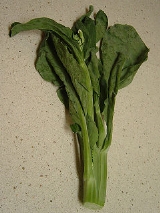
Kai-lan
Encyclopedia
Kai-lan, also known as Chinese broccoli, is a leaf vegetable
featuring thick, flat, glossy blue-green leaves with thick stems and a small number of tiny, almost vestigial flower heads similar to those of broccoli
. Broccoli and kai-lan belong to the same species Brassica oleracea
, but kai-lan is in the group alboglabra [Latin albus+glabrus white and hairless]. Its flavor is very similar to that of broccoli, but a bit bitter.
Broccolini
is a hybrid between broccoli and kai-lan, produced by Mann Packing Company, Inc.
Kai-lan is eaten widely in Chinese cuisine
, and especially in Cantonese cuisine
. Common preparations include kai-lan stir-fried
with ginger
and garlic
, and boiled
or steamed and served with oyster sauce
. It is also common in Vietnamese cuisine, Myanmar (as ကိုက်လန်) and Thai cuisine.
Leaf vegetable
Leaf vegetables, also called potherbs, green vegetables, greens, leafy greens or salad greens, are plant leaves eaten as a vegetable, sometimes accompanied by tender petioles and shoots...
featuring thick, flat, glossy blue-green leaves with thick stems and a small number of tiny, almost vestigial flower heads similar to those of broccoli
Broccoli
Broccoli is a plant in the cabbage family, whose large flower head is used as a vegetable.-General:The word broccoli, from the Italian plural of , refers to "the flowering top of a cabbage"....
. Broccoli and kai-lan belong to the same species Brassica oleracea
Brassica oleracea
Brassica oleracea, or wild cabbage, is a species of Brassica native to coastal southern and western Europe, where its tolerance of salt and lime and its intolerance of competition from other plants typically restrict its natural occurrence to limestone sea cliffs, like the chalk cliffs on both...
, but kai-lan is in the group alboglabra [Latin albus+glabrus white and hairless]. Its flavor is very similar to that of broccoli, but a bit bitter.
Broccolini
Broccolini
Broccolini is a green vegetable similar to broccoli but with smaller florets and longer, thin stalks. Although often misidentified as young broccoli, it is a cross between broccoli and kai-lan, Chinese broccoli...
is a hybrid between broccoli and kai-lan, produced by Mann Packing Company, Inc.
Kai-lan is eaten widely in Chinese cuisine
Chinese cuisine
Chinese cuisine is any of several styles originating in the regions of China, some of which have become highly popular in other parts of the world – from Asia to the Americas, Australia, Western Europe and Southern Africa...
, and especially in Cantonese cuisine
Cantonese cuisine
Cantonese cuisine comes from Guangdong Province in southern China and is one of 8 superdivisions of Chinese cuisine. Its prominence outside China is due to the great numbers of early emigrants from Guangdong. Cantonese chefs are highly sought after throughout the country...
. Common preparations include kai-lan stir-fried
Stir frying
Stir frying is an umbrella term used to describe two Chinese cooking techniques for preparing food in a wok: chǎo and bào . The term stir-fry was introduced into the English language by Buwei Yang Chao, in her book How to Cook and Eat in Chinese, to describe the chǎo technique...
with ginger
Ginger
Ginger is the rhizome of the plant Zingiber officinale, consumed as a delicacy, medicine, or spice. It lends its name to its genus and family . Other notable members of this plant family are turmeric, cardamom, and galangal....
and garlic
Garlic
Allium sativum, commonly known as garlic, is a species in the onion genus, Allium. Its close relatives include the onion, shallot, leek, chive, and rakkyo. Dating back over 6,000 years, garlic is native to central Asia, and has long been a staple in the Mediterranean region, as well as a frequent...
, and boiled
Boiling
Boiling is the rapid vaporization of a liquid, which occurs when a liquid is heated to its boiling point, the temperature at which the vapor pressure of the liquid is equal to the pressure exerted on the liquid by the surrounding environmental pressure. While below the boiling point a liquid...
or steamed and served with oyster sauce
Oyster sauce
Oyster sauce describes a number of sauces made by cooking oysters. The most common in modern use is a viscous dark brown condiment made from sugar, salt and water thickened with cornstarch, flavoured with a little oyster essence or extract and some versions may be darkened with caramel, though high...
. It is also common in Vietnamese cuisine, Myanmar (as ကိုက်လန်) and Thai cuisine.

